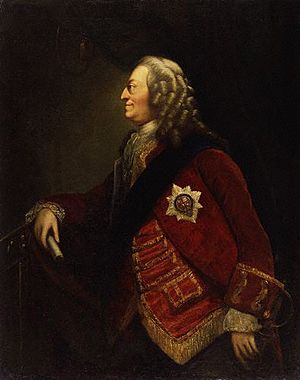Thomas Worlidge facts for kids
Thomas Worlidge (1700−1766) was an English artist known for his paintings and etchings. He created many portraits and was especially good at making detailed etchings, which are like prints made from metal plates.
Early Life and Training
Thomas Worlidge was born in Peterborough in 1700. His parents were Catholic. He moved to London to study art. His first teacher was Alessandro Maria Grimaldi, an artist from Genoa. Worlidge even painted portraits of Grimaldi and his wife around 1720. He later married Grimaldi's daughter and stayed close with the family. He also learned from another artist named Louis Peter Boitard.
Around 1736, Worlidge and Grimaldi's son visited Birmingham. There, Worlidge helped bring back the art of painting on glass. For a while, he also worked as a portrait painter in Bath.
Life in London
Around 1740, Worlidge settled in London, near Covent Garden. He lived in this area for the rest of his life, moving between different streets like Bedford Street and King Street. In 1763, he moved to a large house on Great Queen Street.
He spent his later years enjoying time at a country house in Hammersmith. Thomas Worlidge passed away on September 23, 1766, and was buried in Hammersmith church. A special stone with a poem was placed on the church wall to remember him.
Artistic Creations
Worlidge was skilled in many art forms. His portraits painted with oil and pastel were quite popular. He first became known for his tiny, detailed miniature portraits. Later, he became famous for his drawings of faces made with a blacklead pencil. Important people in society often asked him to create these drawings.
He then focused on etching, a technique where you scratch designs onto a metal plate to make prints. He worked in the style of the famous artist Rembrandt. Worlidge even copied some of Rembrandt's prints, including a self-portrait and a famous print called the "hundred-guelder plate." One of his best etchings was a copy of Rembrandt's portrait of Sir John Astley. You can see examples of Worlidge's drawings and etchings at the British Museum.
One of Worlidge's most well-known etchings showed the installation of John Fane, the Earl of Westmorland, at Oxford University in 1761. In this detailed print, Worlidge included himself drawing the scene, along with his second wife and his brother-in-law, Alexander Grimaldi. Many of the faces in the etching are portraits of real people. Another popular etching he made was of a famous bust (a sculpture of a head and shoulders) of Cicero, a Roman statesman, which was located in Oxford.
In April 1754, Worlidge held an auction to sell many of his artworks. The collection included paintings of historical scenes, portraits, landscapes, and still life. The highest price paid was for a painting that looked like a "fine head" by Rembrandt. After Worlidge passed away, over 1,600 prints and 1,300 drawings by him were sold by his widow in 1767.
Worlidge's final major project was a series called Antique Gems. This collection had 182 etchings of ancient gems. He started publishing parts of it as early as 1754, but he died before it was finished. His students, William Grimaldi and George Powle, completed the work. His widow published the full series in 1768. The front page of the book, dated 1754, shows Worlidge drawing the Cicero bust, with a portrait of his second wife in the background.
Family Life
Thomas Worlidge was married three times. His first wife was Arabella Grimaldi, the daughter of his first art teacher. She passed away before 1749. His second wife was named Mary.
In 1763, he married his third wife, Elizabeth Wicksteed. Elizabeth helped Worlidge with his art and was also known for her skill in copying paintings using needlework. After Worlidge's death, she continued to sell his etchings from their home.
Worlidge is said to have had many children, but only one son, Thomas, from his third marriage, lived longer than him. This son later moved to the West Indies.
Images for kids





